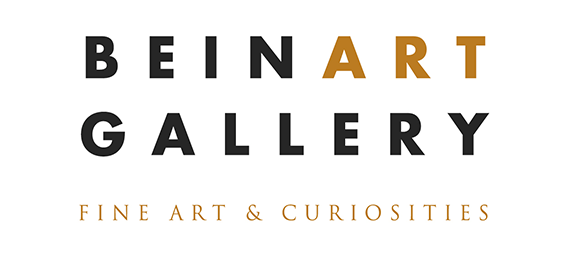 “Occupy” (2012)- Oil painting by Martin Wittfooth
“Occupy” (2012)- Oil painting by Martin Wittfooth
In the world depicted by Martin Wittfooth, humans are conspicuously absent, but their detritus remains: a junked car, a well-appointed apartment, a partially demolished building. That world is given over to animals in paintings that are at turns alarming, sad, and mysterious but unfailingly beautiful. Wittfooth’s work encourages us to think about our place in this world perhaps precisely because we are not in it.
"Everywhere and at all times, we’ve been busy making things in our present for the simple purpose of communicating something, and thus sending messages into our future. What a peculiar habit. We’re the only species inhabiting this planet that routinely behaves this way, and there’s something really beautiful and profound about that.” —Martin Wittfooth
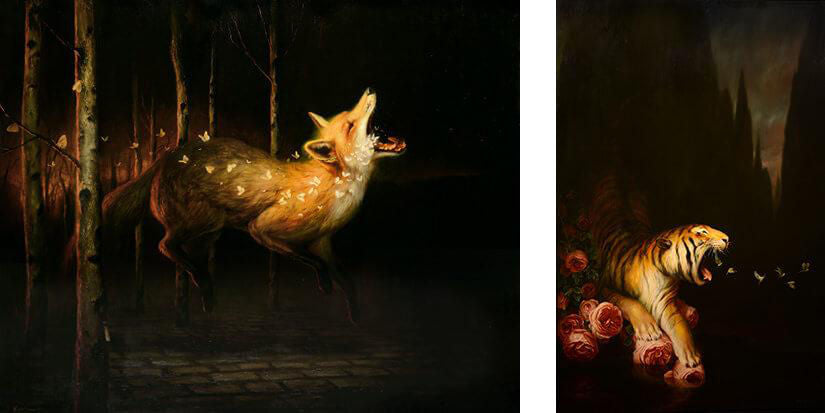 “Nocturne II” (2012) - Oil painting & "Nocturne" (2012) - Oil painting
“Nocturne II” (2012) - Oil painting & "Nocturne" (2012) - Oil painting
Julie Antolick Winters: Tell us a bit about your artistic path. How did you set upon art as a life pursuit?
Martin Wittfooth: I’ve always been somewhat intuitively drawn to visual art, especially representational painting. I’m not sure where this taste or inclination comes from—perhaps it is not dissimilar from the subjective desires of a person’s taste buds or innate gravitation to certain music, and just like these tend to do, my tastes and interests have gotten broader with age and while exploring my own work over the course of my life. I was always drawing as a kid. Allegedly this was something that I started doing at a very early age, as with most people. In my case it was just something I kept doing.
Sometime in the early years of high school I knew that I wanted to focus most of my studies and time into art projects and classes, and thankfully I found a school in Toronto that offered a pretty wide variety of art classes. We had a painting class, an illustration class, life drawing, and a few other options, all of which I took advantage of. This helped me build a pretty solid portfolio with which to apply to college. I got my undergrad in illustration at a school outside of Toronto. It had a strong focus on studio time (meaning less heavy on theory, more heavy on practice), and it set me on a pretty good path as far as figuring out what mediums I wanted to work with, the foundations of strong compositions, problem solving an idea visually, and so on. While at that school I thought I’d end up illustrating for a living, which was something I pursued for a while after school, though I kept returning to oil paint as the medium I most wanted to work with. It’s got such a long history and can have such a “living” essence about it—something that I always felt was lacking in my experimentations with acrylic and digital mediums, for instance. There’s something about standing in front of a great oil painting that just projects something genuine, something that breathes. It’s hard to explain, but it’s something I’ve always found to be irresistible, and inevitably it was something I wanted to try and capture in my own work as well.
 Untitled (2014) - Oil painting by Martin Wittfooth
Untitled (2014) - Oil painting by Martin Wittfooth
So after school I tinkered around for a while and despite some flirtations with perhaps quicker mediums, which made sense to try and apply to illustration jobs with short turnarounds, I started working on a personal series, all in oils. Eventually I submitted some of this work to La Luz de Jesus’s annual group show, Everything But the Kitschen Sync, and got two pieces in. This was a huge game changer for me, to be honest. My very first time having my work in a gallery, and in Los Angeles of all places! I thought a kind of new avenue opened up, that maybe I should try and go down it for a while and see what might be discovered. Right around this time, I got accepted into the MFA program in illustration at the School of Visual Arts in New York, and during the two years in that program I had a chance to really start exploring oils as a medium, and [to go] deeper into personal ideas and ruminations that I hoped to somehow be able to start discussing via the medium. I met and learned from some great instructors, and in the time I’ve lived here (for the past decade), I’ve met a host of very talented artists as well, and my interactions with all of these people have had a tremendous influence on my work, and my thoughts in general.
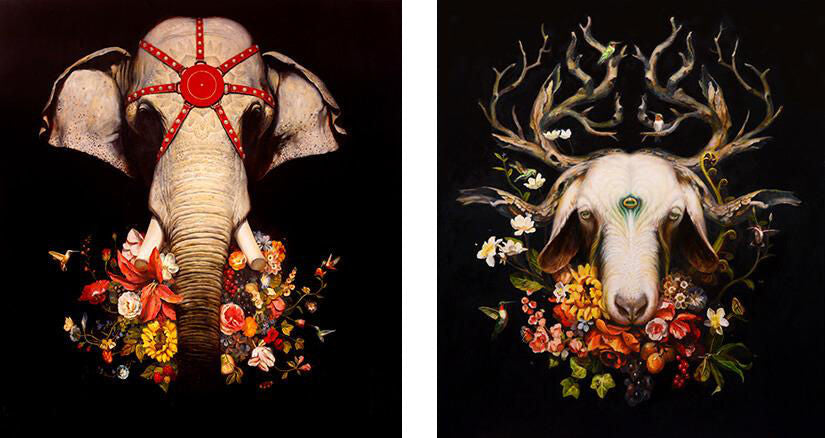 "Incantation" (2014) central panel of triptych with Jean Labourdette - Oil and gold leaf & "Shaman II" (2014) - Oil
"Incantation" (2014) central panel of triptych with Jean Labourdette - Oil and gold leaf & "Shaman II" (2014) - Oil
JAW: What pulled you into a classical approach to painting?
MW: Classical oil paintings often have something really incredible trapped inside of them: a kind of time capsule into eras and the philosophies and social culture of past times, which only art can give us a genuine glimpse of. Many classical paintings echo this sentiment that artists throughout human history have doubtless always been aware of—that we all share an instinct or desire, for some reason, to alchemically process the reality of our senses and thoughts into some “object” that can be shared with one another.
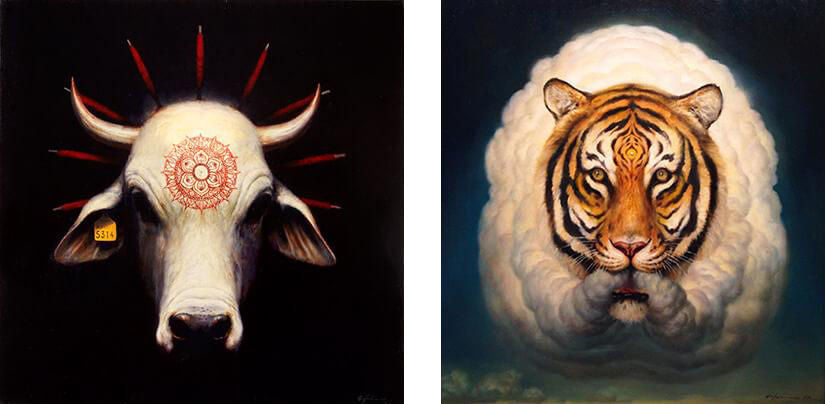 "Brahman" Sacrifice (2014) - Oil and gold leaf & "Atman" Mirage (2014) - Oil and gold leaf
"Brahman" Sacrifice (2014) - Oil and gold leaf & "Atman" Mirage (2014) - Oil and gold leaf
Once in a while I bandy this question around with other artists: “If you discovered that you were the only person left on Earth, with an endless supply of materials on hand, would you still make art?” I’m not exactly sure what my answer is, but I’m inclined to say no, because there’d be nobody that the work could speak to, other than myself. Looking at classical paintings, and connecting with some of them on a very deep level, leads me to believe that many of the classical painters share this sentiment. Through all this time that’s passed over the entire history of human art, these objects—these fingerprints—can reach us and communicate with us all this time later. We get these snapshots of our shared story on this planet, and the reminder that throughout it, we have all explored individual paths, while at the same time there are essential aspects about us that are united, including the desire to make art in the first place. We find this instinct practiced and explored in caves from the very dawn of our species throughout the world, we see it in the ancient temples of South America, Northern Europe, in Asia, in Africa, in the artifacts of the Renaissance, in the construction of modern-day New York City at the turn of the centuries. Everywhere and at all times, we’ve been busy making things in our present for the simple purpose of communicating something, and thus sending messages into our future. What a peculiar habit. We’re the only species inhabiting this planet that routinely behaves this way, and there’s something really beautiful and profound about that. I often think about what the psychedelic thinker Terence McKenna called “The Archaic Revival”: a yearning to look into the past to see meaning, connection, the sacred, looking back at us. I need those reminders sometimes, when the current state of human affairs seems dire and in need of a new perspective.
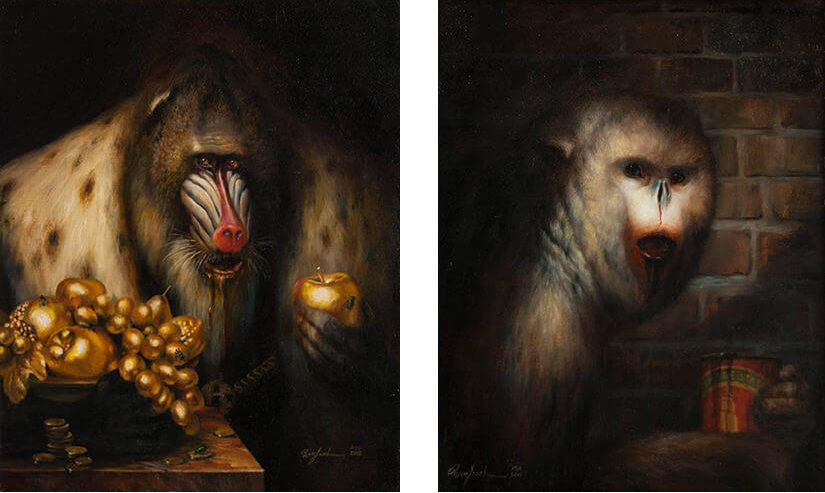 "The Gold Merchant" (2012) - Oil painting & "The Addict" (2012) - Oil painting
"The Gold Merchant" (2012) - Oil painting & "The Addict" (2012) - Oil painting
JAW: Although your work overall deals with the impact of humankind upon the natural world, you have said that you try not to be too specific in presenting particular facets of that in your paintings. As you begin a piece, do you start with a precise problem or focus, and if so, how do you expand from that?
MW: I tend to explore my personal paintings in series, whereby there is a larger theme that sits like an umbrella over the whole body of work. Individual paintings within these series explore facets of the broader theme, and as such each painting in that series kind of speaks to one another, and usually presented as a solo show they all form a sort of unit. It’s nice to feel that—to walk into a space and somehow feel that the whole room is speaking to you at once in a way. This is why I often take issue with the art fair model of viewing work: there’s just too much going on at once, whereas museum rooms are often curated so as to have everything inside of it form a kind of symphony. The Frick Collection in New York does a great job of this, by the way, if anyone reading this interview is interested in checking it out. The museum is actually inside of the collector’s mansion on the Upper East Side, so as you walk through his collection you travel through the various rooms of the house. The rooms and alcoves have time period themes to them, and the artwork is hung in such a way as to play off of this.
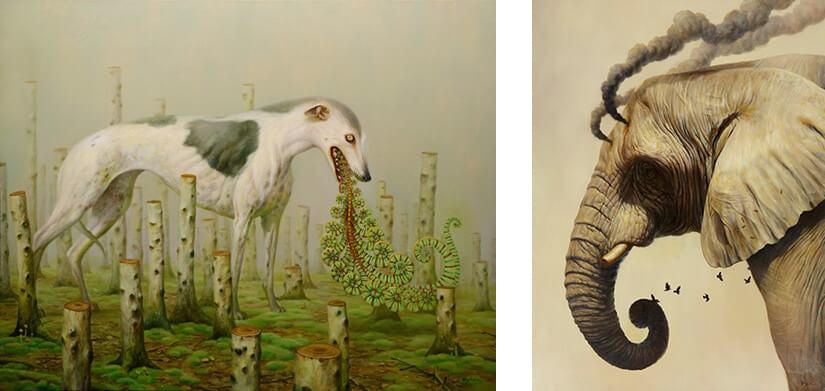 "Shaman I" (2014) - Oil painting & "Smoke Signals" (2013) - Oil painting
"Shaman I" (2014) - Oil painting & "Smoke Signals" (2013) - Oil painting
In my own work, the themes that form the basis for these solo show series are all in their own way a kind of meditation on topics that I’ve been thinking about at length because they interest me personally, and the individual paintings I create within them often springboard from one to the next: once I’m underway on a particular piece, the concept for another one tends to materialize. It’s a fun process, and I feel [it] lets me really sit with an idea for a long time and keep my focus on exploring it. I suspect that an author writing a book might feel the same way, the countless hours spent on research and writing on a particular topic or character plot line.
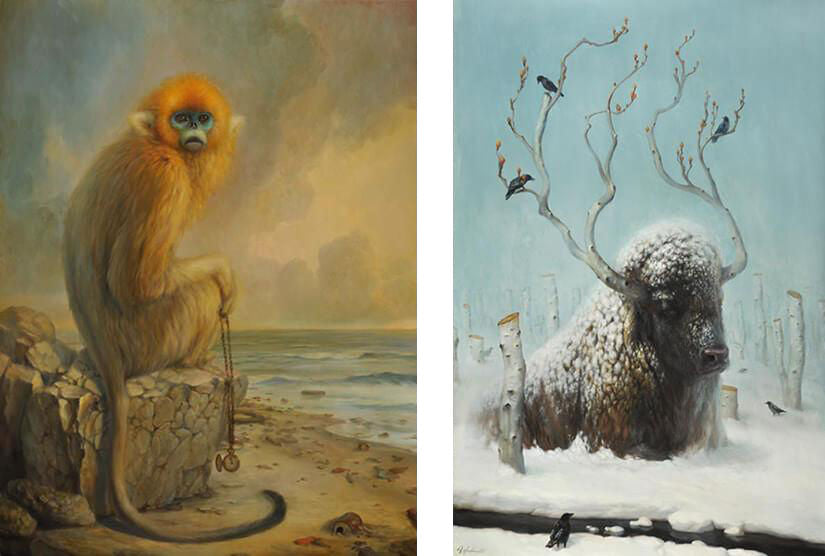 "Memento" (2010) - Oil painting & "Spring" (2010) - Oil painting
"Memento" (2010) - Oil painting & "Spring" (2010) - Oil painting
JAW: Fire and smoke have been running themes in your work. What is your attraction to these elements?
MW: Fire and smoke are rather blunt symbols for destruction, and for a while I incorporated these elements rather clumsily to get at that point, though in recent works I’ve been bringing [them] in for more nuanced reasons. My 2011 series, The Passions, for instance, incorporated fire as a stand-in for the halo. That show dealt with blind faith and the persistent and troubling human meme of martyrdom. So in that series I borrowed titles and compositions from classical paintings and sculptures that portrayed this topic but replaced instances of “holy light” with fire, and that kind of thing. Another thing is [that] I love instances of light within a painting, which from a painter’s perspective offer fun stuff to explore. Painting fire is really interesting, as it’s very organic in its structure: alive and ever-transforming, affecting the color and temperature of the elements around it.
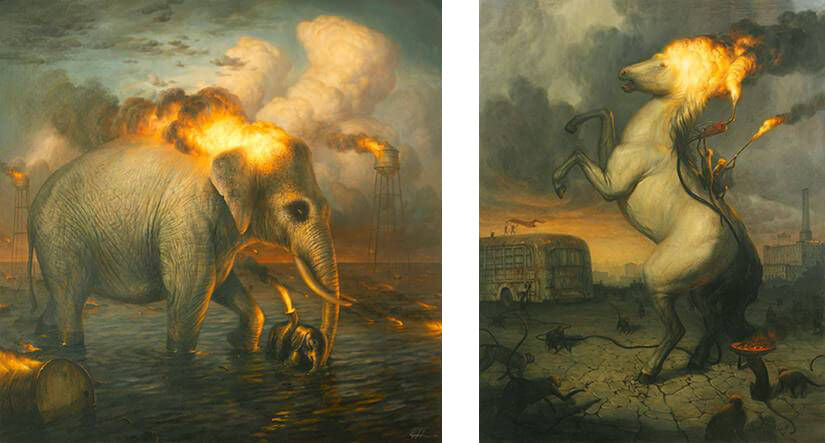 "The Baptism" (2011) - Oil painting & "The Sacrifice (2011) - Oil painting
"The Baptism" (2011) - Oil painting & "The Sacrifice (2011) - Oil painting
JAW: What guides your decisions of which animals to use in your work? Are the animals ever symbolic? For example, hummingbirds, which appear in a few pieces, can be considered messengers or symbols of healing; is that at work in the pieces in which they appear?
MW: Yes, the animals that I choose have something in their form, or body language, or our collective association with them that informs why I pick them. As a species we share a pretty significant degree of similar reactions to the natural world: there are forms in nature that we seem to have innate responses to. Like a sense of awe or respect for large mammals, and revulsion for spiders and snakes. I’m interested in this kind of shared pattern recognition and instinctive responses. I’m pretty invested in trying to imbue my paintings with some sense of “presence” and hence am working with subject matter that can impart an emotional reading of it, not just a rational (strictly observing) analysis. Trying to chase this idea, I’ve also become really mindful of the scale of my pieces and how that affects how the painting resonates: ideally I would like for you to “feel” that there is this animal standing in the room with you when you when you look at my work, and I believe I can only achieve that by letting the scene I want to portray and its inhabitants determine the size of the painting.
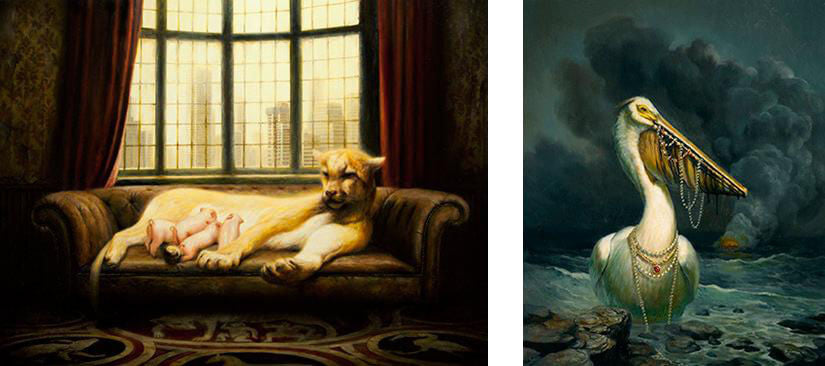 "The Heirs" (2012) - Oil painting & "The Spoils" (2012) - Oil painting
"The Heirs" (2012) - Oil painting & "The Spoils" (2012) - Oil painting
JAW: Jean Labourdette is another favourite artist in the Beinart Collective. Tell us about your collaboration with him last spring. How did that come about, and how did you put together the pieces on which you collaborated?
MW: Soon after showing together in a group show at Yves Laroche Gallery in Montreal and taking a trip out to Miami Art Basel together with the gallery crew that same year, we became close friends. I think we have always had this mutual appreciation for each other’s work and that introduced us, but we also share a very similar mindset about the world and our lives in it. So we had been talking for quite a long time about a collaborative show, and in 2013 we created a painting together for a large museum show curated by Hey! at La Halle St-Pierre Museum, a triptych in the style and borrowed theme of classical altarpieces. It was a really fun and rewarding project. Shortly after that the opportunity came up to do a 2-person show at Roq La Rue Gallery in Seattle, and we jumped on it. We worked with the premise of one theme and worked on individual paintings tied to it, and [we] created another triptych piece together to serve as the anchor piece for the show.
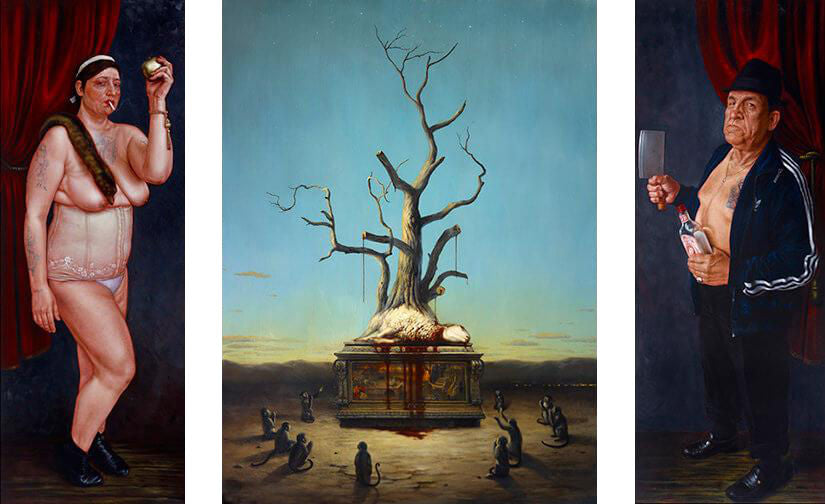 "The Adoration of the Mystic Lamb" (2013) Collaborative triptych with Jean Labourdette - Oil painting
"The Adoration of the Mystic Lamb" (2013) Collaborative triptych with Jean Labourdette - Oil painting
JAW: Whose work do you find exciting right now, and why?
MW: There are many, many artists out there right now that are doing super interesting and inspiring stuff, so it’s hard to narrow it down. I’m really encouraged by what’s happening right now: it’s as though many artists who might [have] previously felt marginalised have amazing platforms from which to have their works seen and appreciated, and it’s encouraging a lot of people, it seems, to push the envelope and keep elevating each other in the process.
JAW: You’ve had several solo shows over the last handful of years, starting almost right after you obtained your MFA degree. Do you find that the shows guide the flow of your work, or are the shows put together on the basis of what you’re working on when you get the opportunity to exhibit?
MW: Gallery shows are a great incentive for planning out a large series: the fact that this series will be exhibited in a particular space also informs the scope and scale of it. So, far ahead of time, when I’m first starting to plan out a show, I get floor plans if the gallery has them and take shots of the space. Some of the elements can affect what theme I choose to explore for a particular series.
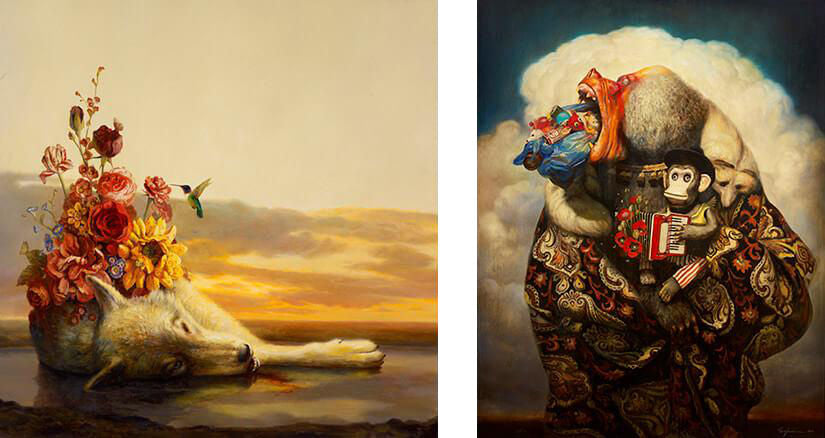 "Fall/Advent" (2012) - Oil painting & "Ventriloquism (Politik 1)" (2014) - Oil painting
"Fall/Advent" (2012) - Oil painting & "Ventriloquism (Politik 1)" (2014) - Oil painting
JAW: You’re an extremely accomplished painter at a relatively young age. Is there a style or medium that you’d maybe secretly like to try that would be a huge departure for you?
MW: Thanks for saying that. Yes, I would very much like to explore sculpture in the future and site-specific installation work. I have something planned for a museum show in the next couple of years that will be an attempt at a large-scale installation. I’m really excited for it.
JAW: What is your vision of your future in art?
MW: I would like to feel at each new year that I continue making art that I’m still exploring, and not taking it for granted. I want to constantly improve some aspect of my painting, and keep going deeper down the rabbit holes I’ve stumbled into.
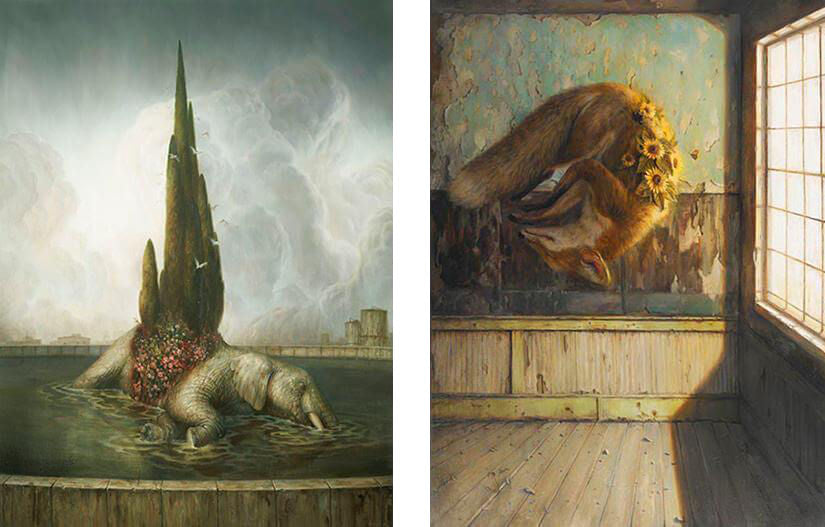 "Fountain" (2011) - Oil painting & "New Suns" (2010) - Oil painting
"Fountain" (2011) - Oil painting & "New Suns" (2010) - Oil painting
This interview was written by Julie Antolick Winters for the Beinart Collective in 2015.
Julie Antolick Winters is a writer and editor residing in the state of Maryland, USA, in a small city near Washington, D.C. Julie cowrote the introduction for Black Magick: the Art of Chet Zar and co-copyedited this book and Kris Kuksi: Divination and Delusion for Beinart Publishing. She has also been conducting artist interviews for the Beinart Collective & Gallery since 2010. In addition to her work for the Beinart Gallery, she edits science articles and books, writes poetry and practices the art of negotiation with her son.




 Cart
Cart


